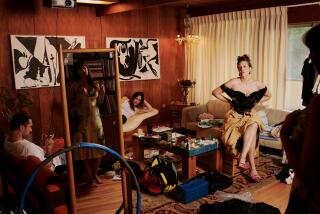The Envelope: ‘Martian’ spacesuits had to look ready to survive space but be ready to survive lights, cameras, action
- Share via
If you’re going to make the most technologically advanced, realistic spacesuit costume in just eight weeks, it pays to go to the experts. To create a range of suits for director Ridley Scott’s “The Martian,” the tale of an astronaut stranded on Mars, costume designer Janty Yates worked closely with NASA, visited the Jet Propulsion Laboratory in Pasadena, consulted with the Smithsonian and spoke to the institution’s spacesuit curator.
As astronaut Mark Watney, actor Matt Damon spent the bulk of his screen time in an orange, white and gray “surface suit” that artfully blended movie magic and high-tech engineering. Though the cinematic suits don’t have to withstand space travel, they do have to provide oxygen, sound, comfort and compatibility with cameras and lights. To manufacture and design the many components, Yates worked with spacesuit costume design expert Michael Mooney, along with Grant Pearmain and Andrew Dow, co-founders of London special effects company FBFX.
SIGN UP for the free Indie Focus movies newsletter >>
The suit:
“It was a functional piece of equipment,” said Mooney. Yates drew on wetsuits and motocross racers to realize Scott’s request for a streamlined style. The suit was given space-age texture with dimensionally printed neoprene — digitally designed raised-ink patterns.
Between takes, the suit needed to be quickly disassembled to allow each department access to adjust sound, makeup and lighting. FBFX built removable compartments that attached magnetically and housed equipment relevant to specific functions. “It saves on this huge de-rigging you would have to do to get to these things normally,” Pearmain said.
The helmet:
Computers aided the design and machining of many parts, some of which were created by various high-resolution 3-D printing methods. Those pieces were hand-polished, then vacuum cast to create finished parts. To avoid glare or ripples, the helmet required durable, flawless glass, the same kind used in Aston Martin headlights. To illuminate the actors’ faces, FBFX engineers custom-built dimmable LED lights with miniaturized remote controllers that prevent flickering on camera. Customized circuit boards inside each helmet retained the complex settings between takes.
“The helmets were wired for sound so [the actors] could hear Ridley and speak to each other — and record to the standard to be used in the actual film,” Yates said. “Then we had to keep them alive, so there were two huge air pumps in the helmet and the batteries in the backpack.” Fan speed was adjustable to minimize noise from rushing air and rotating blades. Filters housed in backpacks removed vast amounts of dust blown at the actors to simulate a violent Mars sandstorm.
The cooling suit:
Borrowing technology from race car drivers, Yates kept the actors cool between takes with an undergarment built with hoses that circulate cool water. “The costume department adapted them to make them look a little more NASA. The hoses had to be designed to look futuristic to fit in with the suit instead of the old rubber hoses that they really are,” Pearmain said.
The accessories:
Yates coordinated with concept artists, special-effects engineers and specialty costume designers who contributed to making realistic components — the gloves, boots, belts and backpacks. Many small details were 3-D printed and vacuum-cast, others composed one layer at a time with stereolithography. However, the yoke that fit like a chest harness was hand-sculpted and molded from a lightweight urethane similar to that in car bumpers. Jewelers hammered and etched metal pieces, while embroiderers, printers and painters created surface decorations and details. NASA even weighed in on the proper logos.
“We don’t want it to look like a costume,” said Mooney. “We want it to look like a real spacesuit.”
More to Read
Sign up for The Envelope
Get exclusive awards season news, in-depth interviews and columnist Glenn Whipp’s must-read analysis straight to your inbox.
You may occasionally receive promotional content from the Los Angeles Times.








